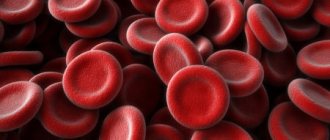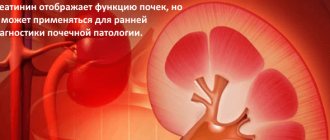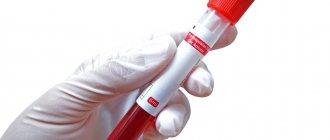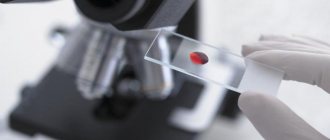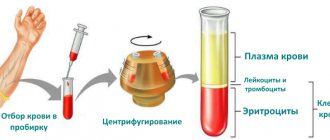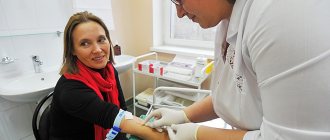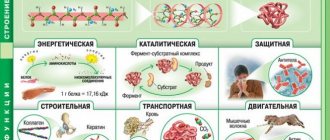Erythrocyte sedimentation rate (ESR) is a laboratory test that determines the time at which blood separates into plasma and red blood cells. Despite the low specificity of the test, the normal ESR indicator in women is necessarily determined as part of a general blood test.
Among the advantages are high susceptibility to any inflammatory changes in the body. Disadvantage: inability to accurately identify the cause of deviation from the norm. There are cases when a high level of ESR is detected in completely healthy women.
You should know exactly the normal ESR in women for different ages and stages of pregnancy.
Blood tests for human immunodeficiency virus
The study of biological material, which is blood, remains the most informative method. Before taking an HIV test, they try to take into account the behavior of the virus. It manifests itself in plasma, although it is found in seminal fluid and vaginal mucus. HIV testing is a multicomponent diagnosis. Blood is taken for various studies:
- Blood test for HIV. Often the virus is first detected when taking a blood test for HIV and hepatitis.
- A general blood test is also prescribed for HIV. It will show specific indicators of leukocytes, platelets, hemoglobin, erythrocyte sedimentation rate (ESR). But these same nuances sometimes indicate other viral infections; in case of deviation from the norm, other blood tests are prescribed.
Important! If you don’t know how HIV tests are done, on an empty stomach or not, doctors will answer: biological material is collected on an empty stomach. This ensures reliable results.
- Rapid tests for HIV. They give results within 30 minutes. They study not only blood, but also saliva and urine. The test is informative in terms of diagnosing infection and the number of antibodies. Sometimes it happens that the test for HIV is positive, but the analysis is negative. The result is false negative if the infection occurred recently. You will need to undergo this examination in 6 weeks.
- Enzyme immunoassay. Serum is isolated from the blood, where antibodies to the human immunodeficiency virus are looked for. When patients ask how long it takes to test for HIV, doctors answer: up to 10 days. But even here the possibility of erroneous results remains. This is affected by autoimmune diseases, exacerbations of chronic diseases, and cancer.
When wondering where you can get tested for HIV, you should contact a private laboratory, AIDS and HIV prevention and control centers, but the easiest way is to donate blood at a public clinic at your place of residence. Anonymity remains a positive aspect of every medical institution.
You can find out how much your AIDS test costs in advance. The price for HIV analysis ranges from 300 to 12,000 rubles. Research in private laboratories and highly sensitive tests remain more expensive.
Carrying out analysis
Like many other diagnostic examinations, for clinical analysis you need to come to the clinic on an empty stomach in the morning. As a response, the woman receives a table with a breakdown of the general laboratory blood test. This form is prepared within a few hours and then handed over to the attending physician or to the patient.
The UAC considers the following parameters:
- The amount of hemoglobin,
- RBC content,
- Color indicator of blood,
- Reticulocyte count,
- platelet level
- Creatinine,
- ESR (ROE),
- Leukocytes, presented in the form of a leukocyte formula.
Let's take a closer look at each characteristic.
Diagnostics
Conventionally, diagnostic studies are divided into 2 types. The first group helps determine the fact of infection. Such tests can establish control over the course of the infection and indicate the effectiveness of treatment.
The second group determines antibodies to the human immunodeficiency virus, p24 antigen (serological tests) and viral RNA, provirus DNA (molecular genetic tests).
A detailed diagnosis is prescribed after a general blood test has been performed, which is advisable to do in case of HIV. HIV infection occurs in different stages: from an asymptomatic state to an acute phase, like AIDS. During it, the body suffers from opportunistic diseases, while the immunity of healthy people can resist them. This will be demonstrated by general blood cell counts.
Diagnostics helps to determine the number of leukocytes. Future treatment and quality of life also depend on the ratio of them and antibodies to the virus. In addition to general methods, specific techniques are also used.
Polymerase chain reaction
This is one of the most effective methods for diagnosing infection. Its results are 90–99% true: the test does not detect antibodies to the virus, but its RNA. This HIV test has a short readiness time - up to 3 days.
Immunoblotting
This is a highly sensitive and not the cheapest method for recognizing a viral infection. It involves separating the viral proteins, after which they are transferred to a nitrocellulose membrane. After the electrophoresis procedure, its antigens, which differ in molecular weight, are compared with the samples on the test strip. The method shows at what stage of immunodeficiency a person is.
Benefits of undetectable low load
A low or undetectable viral load is desirable for several reasons.
- Minimal risk of infection progression.
- Minimal risk of developing resistance to HAART drugs.
- Minimal risk of transmission of infection during unprotected sex.
- Maximum chance of having a healthy baby (for women).
Thus, the quality and life expectancy of an HIV-infected patient are significantly increased. At the same time, he does not pose a potential threat to his sexual partners, because the transmission of HIV at zero load, or rather at an uncertain load, is practically excluded. Yes, a certain risk remains, but the use of condoms reduces it to “0”. Not to mention the fact that a person has the opportunity to have healthy children.
Norms
In a healthy person, the CD-4 immune index is 400-500 – 1600 cells/ml. If the number decreases to 200-500, changing every six months by 45 units, there is a high probability of infection. But the possibility of diseases affecting immune processes, pregnancy and breastfeeding in women is also taken into account.
Also, a blood test for HIV has standards for infected people. If the cell count drops to 350, it’s time to start therapy. Thanks to this, concomitant diseases that are dangerous for infected people will not develop.
If the number has dropped to 200 units, highly active antiretroviral therapy is often prescribed. Those suffering from immunodeficiency are advised to get tested for HIV and hepatitis. Liver diseases often accompany a dangerous virus and aggravate the immune system.
Important! Half of the cases of infection are diagnosed after a blood test has been performed for hepatitis, rw and HIV: after a woman registers for pregnancy, during medical examinations, before donating blood.
Leukocytes
These blood cells are considered protective. When a blood test is performed, the decoding, the norm in women can tell the doctor whether the body is ready to fight viruses, infections and harmful microorganisms or toxic substances. The normal value differs slightly depending on the age and gender of the patients.
If the leukocyte values are below normal, this indicates blood pathologies, viral infections, adverse effects of using certain medications, and hepatitis. If the level is too high, then this means the presence of a bacterial infection or significant bleeding in the body.
What is viral load
Those infected are interested not only in the value of CD-4. The number of dangerous virus particles in the blood plasma is important. The load may show an erroneous result due to violation of test conditions, after vaccinations, or due to previous diseases. This also applies to healthy people. But if after a month the indicator increases by 3-5 times, this is a reason to think about it.
Much depends on the health status of the infected person. It is characterized by blood cells, in particular, those responsible for fighting foreign bodies, including viral infections.
About where it all started
In 2006, I started having problems with my skin, I had terrible eczema, I went to the doctor in Bendery.
They took my blood for analysis and prescribed treatment for scabies. It took me a month to treat her. I only got worse, and I came to them again. They took my blood again. For this reason, a car even came to the house, they explained that the previous analysis had failed. And again they didn’t say why and what the result was. I began to suspect, took a referral to Chisinau, went for a skin examination, I was treated all summer, but to no avail. It was 2006, I was covered in fungus and eczema and no one suspected anything.
And then, tired of all this, in search of adequate doctors, I ended up at the department of dermatology. I remember how after the examination the doctor told me: “You know what, you probably have AIDS.” And I: “How?!” After that I returned to Bendery. And finally they called me and told me that I had HIV. I spent almost six months in such ordeals.
Results and interpretation of analyzes
Enzyme immunoassay results may vary. They identify different protein compounds present in the virus envelopes. The sets of proteins in test systems may differ, but if 3 main ones are detected, the test will give a positive result.
Scientists identify the following indicators:
- Up to 20 thousand copies/ml – insufficient RNA concentration. This is a good result for an infected person. In a healthy person, the indicator should be zero.
- From 20 thousand to 100 thousand – the middle stage, characterized by primary or secondary manifestations of immunodeficiency.
- From 100 thousand to 450 thousand is considered a deadly indicator. The higher the number, the greater the likelihood of developing AIDS.
Important! You can donate blood again if you have a false negative, false positive or incorrect result. A negative result is true if there is no risk of infection in the 12 weeks before blood collection.
About accepting a diagnosis
I was 46 years old at that time, and when I received the results of all the tests, I only had 8 immune cells.
When they told me about the diagnosis, I felt so bad that I didn’t even try to look for the reason, I decided to survive by any means necessary. I was admitted to the hospital for a month and a half, then I posted encouraging affirmations about HIV throughout the ward, read Louise Hay, convinced myself and other patients that this was not the end. Every morning I made everyone do exercises, we put on makeup before going around, we always put ourselves in order.
I spent a month and a half in the department. I was discharged with 10 immune cells. I felt very bad for 10 days, then there was a crisis night, then I clearly felt that something would happen that night - either I would remain alive, or it would be the end. Then some kind of vacuum formed, someone talked to me, they told me that I would live, I would help people, that I would open my own store. They say that this was a guardian angel.
Routes of transmission of viral infection
The cost of an HIV test makes it accessible to everyone. The relevance of the problem is confirmed by common methods of transmission of infection: the use of unsterile medical instruments, in particular syringes, the route from mother to child, during unprotected sexual intercourse, and through blood transfusion.
When asked how long after a possible infection can be tested for HIV, doctors answer: you need to wait from 3 weeks to 3-5 months.
What to do for infected people and their loved ones:
- Monitor the number of RNA copies of the HIV virus. This reduces the risk of maternal infection of the fetus and also increases the life expectancy of the infected person.
- Get tested in a timely manner and responsibly take courses of antiretroviral therapy.
- Remember that not only the determination of the viral load for HIV is important indicators, their correlation with the results of the immune status is the main component of treatment. Tests are taken regularly.
Since there is no cure for the HIV virus, people with a viral load need to ensure that the number of viral particles does not go beyond the normal range. Even with this diagnosis, you can continue to live a full life.
Source: onvenerolog.ru
Immune status, CD4 count, T-lymphocytes (or T-helpers - white blood cells that are responsible for “recognizing” various pathogenic bacteria, viruses and fungi that must be destroyed by the immune system) - everyone who lives with HIV knows about this , even if he doesn’t really understand the intricacies of his disease. Immune status - the number of CD4 lymphocytes in 1 ml of blood - is the main indicator of the effectiveness of the immune system in HIV. It is these lymphocytes that become the target of HIV, and the normal functioning of the immune system depends on their number. It is based on the immune status (although not only) that the decision to start therapy is made.
There is currently no universal strategy for starting therapy. It is believed that when the immune status drops below 300, especially with sharp negative dynamics and a high viral load (> 100,000), therapy is already mandatory, because a status below 300 is already a potential risk of various opportunistic infections. However, there are studies that show that with earlier initiation of therapy (with a status of 500 and above), the dynamics of status growth are more reliable and stable, but so far, for a number of reasons, one of which is the cost of therapy, it is rare for anyone to be prescribed therapy with such a high immune status .
Immune status is a rather inert thing. In a healthy person, it can range from 800 to 1200. After infection, it slowly begins to decline and drops to dangerous values (< 200), on average, after 6-8 years of infection. If the status drops to values less than 100, then the risk of various diseases becomes high against the background of reduced immunity, and often with such a low status they already talk about the beginning of the AIDS stage. After the start of therapy and suppression of viral replication, which is confirmed by an undetectable viral load, the immune status begins to grow slowly, on average by 50 cells per year. But usually, the lower the status when therapy is started, the slower it recovers. However, I know people who started therapy with a status of several tens of units, and, despite this, they experienced quite sharp positive dynamics. It must be understood that HAART itself does not directly affect the status.
but only suppresses the replication of HIV and allows the immune system to heal itself. Quite arbitrary fluctuations in status are possible, which depend on illnesses (colds), the time of year, the time of day, the fat content of the food you ate, stress, and a bunch of other reasons. Moreover, different test systems may give different CD4 count results. Therefore, status dynamics usually represent a broken line. And that is why it is important to know not the single value of the status, but its dynamics, preferably over a relatively long period of time.
In addition to the absolute CD4 count, they often look at the relative CD4 count - the percentage that CD4 make up of the total family (population) of lymphocytes. Normally it is about 40%. A CD4 percentage of less than 20% is approximately the same as a CD4 count of less than 200 cells/mL.
/Videx K.
Source: myhiv.livejournal.com
Regular monitoring (checking) of CD4 cell count and viral load is a good indicator of how HIV is affecting the human body. Doctors interpret test results in the context of what they know about HIV patterns.
For example, the risk of developing opportunistic infections is directly related to the number of CD4 cells. Your viral load can predict how quickly your CD4 levels might drop. When these two results are taken together, you can predict how high your risk of developing AIDS will be in the next few years.
The results of CD4 cell count and viral load tests will help you and your doctor decide when to start ARV (Anti-RetroViral) therapy or treatment to prevent the development of opportunistic diseases.
CD4 cells, sometimes called helper T cells, are white blood cells responsible for the body's immune response to bacterial, fungal, and viral infections.
CD4 cell count in people without HIV
The normal number of CD-4 cells in an HIV-negative man is from 400 to 1600 per cubic millimeter of blood. The number of CD-4 cells in an HIV-negative woman is usually slightly higher - from 500 to 1600. Even if a person does not have HIV, the number of CD-4 cells in his body depends on many factors.
For example, it is known that:
- Women have higher CD4 levels than men (by about 100 units);
- Level 4 in women may fluctuate depending on the phase of the menstrual cycle;
- Oral contraceptives may reduce CD-4 levels in women;
- Smokers typically have lower CD-4 cell counts than nonsmokers (by about 140 units);
- The CD-4 level drops after rest - fluctuations can be within 40%;
- After a good night's sleep, your CD4 count may drop significantly in the morning but rise during the day.
None of these factors appear to affect the immune system's ability to fight infections. Only a small number of CD-4 cells are found in the blood. The rest are in the lymph nodes and body tissues; Therefore, the listed fluctuations can be explained by the movement of CD-4 cells between the blood and body tissues.
CD-4 cell count in HIV-infected people
After infection, the CD-4 level drops sharply and then settles at 500-600 cells. People whose CD-4 levels initially fall faster and stabilize at a lower level than others are thought to be more likely to develop HIV infection more quickly.
Even when a person does not have obvious symptoms of HIV, millions of his CD-4 cells become infected and die every day, while other millions are produced by the body and rise to protect the body.
It is estimated that without treatment, the CD4 cell count of an HIV-positive person falls by about 45 cells every six months, with greater loss of CD4 cells seen in people with higher CD4 counts. When the CD4 cell count reaches 200-500, it means that the person's immune system has suffered some damage. A sharp drop in the CD4 count occurs about a year before the onset of AIDS, which is why it is necessary to regularly monitor the CD4 level from the moment it reaches 350. The CD4 level will also help decide whether to take medications to prevent certain diseases associated with the stage of AIDS.
For example, if your CD4 cell count is below 200, it is recommended to take antibiotics to prevent infectious pneumonia.
CD4 can fluctuate, so don't pay too much attention to the result of one test. It is better to pay attention to the trend in the CD4 cell count. If a person's CD4 count is high, they have no symptoms, and they are not on ART, they likely need to have their CD4 cell count checked every few months. But if a person's CD4 count drops sharply, if they are participating in clinical trials of new medications, or taking ART, then they should test their CD4 cell count more often.
CD4 cell count
Sometimes doctors not only look at the nominal CD4 cell count, but also determine what percentage of all white blood cells are CD4 cells. This is called a CD4 cell percentage test. The normal result of such a test in a person with an intact immune system is about 40%, and the percentage of CD4 cells below 20% means the same risk of developing a disease associated with the stage of AIDS.
CD4 level and ARV therapy
CD4 can serve to determine the need to start ARV therapy and as an indicator of how effective it is. When the CD4 cell count drops to 350, the doctor should help the person determine whether he or she needs to start ART. Doctors recommend that a person start ARV therapy when the CD4 count drops to 250-200 cells. This level of CD4 cells means that a person is in real danger of developing AIDS, an associated disease. It is also believed that if you start ARV therapy when the CD4 count has dropped below 200, then the person will respond less well to treatment. But at the same time, it is known that there is no benefit from starting therapy when the CD-4 cell count is above 350.
When a person starts taking ARV therapy, their CD4 count should begin to slowly increase. If the results of several tests show that the CD4 level is still falling, this should alert the doctor and inform him that it is necessary to reconsider the form of ARV therapy.
Source: www.antiaids.org
HIV infection
In laboratory conditions, it is possible to measure the number of viral particles in the blood, the so-called viral load. To determine the progression of the disease, changes in the viral load and the number of CO4 cells are monitored.
Determination of viral load is used to assess the activity of the virus in the patient's body. During the study, the amount of viral RNA (ribonucleic acid), a molecule associated with DNA and the genetic material of the virus, is determined in the peripheral blood.
There are currently two tests available to determine viral load:
Polymerase chain reaction (PCR). The PCR test system uses an enzyme that binds to the viral particle and tags it in the blood sample. These markers can be identified and quantified, from which the number of viral particles in the body is calculated;
Method
branched DNA (rDNA).
This test is based on the detection of luminescent particles attached to HIV. Measures the volume of light waves generated
► The human immunodeficiency virus contains many special proteins and genetic material (RNA). Determining their quantity can be used to monitor the development of infection.
these luminescent particles. This indicator is then converted into units of measurement of the number of viral particles. This method is less sensitive than PCR, but it is less labor intensive. The branched DNA method is more often used to monitor the patient's condition over a long period of time.
Viral load is defined as the number of copies of HIV in 1 milliliter of blood. The minimum number of copies that can be detected is 25. Changes in viral load are often measured in logarithmic progression, that is, to the power of ten, in which 1 is a factor of 10, 2 is a factor of 100, and so on. For repeated tests, a change that differs from the previous value by a factor of 3 is diagnostically significant.
4 PCR (polymerase chain reaction) is a method that measures the amount of viral genetic material in the blood.
Inside an HIV virus particle
CD4 cells and susceptibility to infection
The level of CO4 cells, which decreases over a long period of time, may influence the course of the disease and susceptibility to certain opportunistic infections. For example, it is known that reducing their level to 200 is an indication for the preventive treatment of Pneumocystis pneumonia.
REDUCTION IN CD41KJIETOK LEVELS The level of CO4 cells can be reduced gradually, step by step
or sharply. A sharp decrease indicates the activation of HIV and an increased risk of developing AIDS.
Typically, the average rate of decline in CO4 cell levels is approximately 15% per year. The normal number of these cells in healthy people is from 600 to 1200.
▼ Pneumocystis pneumonia develops as a result of impaired immunity. It is a characteristic manifestation of AIDS and is associated with low levels of CD4 cells.
Other methods
B 180 360 SD 720 900 1080 TO 1ФУ1620 1800 1980 2160340®
There are a number of other tests used to monitor HIV infection in a person:
Number of CP8 cells. This type of T cell is also destroyed during infection;
Ratio of CD4 to CD8 cells. An extremely important indicator, since the higher this ratio, the less pronounced the pathological changes in the body;
The level of CD4 cells in relation to the total number of T cells.
▲ A flow cytometer is used to determine the number of CO4 cells infected with HIV. As the infection progresses, their number decreases. A decrease in their level to 200 is a sign of AIDS.
More accurate indicator of health status than isolated CD4 cell determination;
Beta-2-microglobulin and neopterin - an increase in the level of these immune markers indicates a deterioration in immune function.
Gp120—
Binds to the CD4 protein on the surface of T cells and allows the virus to enter the cell.
Viral RNA
This molecule is converted by the virus into DNA, which can bind to cell chromosomes. The amount of viral RNA is measured using the PCR method.
p24 antigens
Proteins that form the core of the virus. Their level can be determined using special antibodies.
Source: zhurnalko.net
Why is immune status determined?
An immune status test determines the number of different cells of the immune system. For people with HIV, the number of CD4 cells (or T4 cells) matters.
CD4 or T4 lymphocytes are white blood cells that are responsible for “recognizing” various pathogenic bacteria, viruses and fungi, which the immune system must destroy.
Information about the CD4 cell count allows the doctor to assess the health of the immune system, whether it is worsening or improving. The word "status" means state.
Accordingly, the greater their number, the better
.
Types of tests needed for HIV
There are several tests that people with the disease must undergo to determine the doctor's further tactics:
- Immunogram with determination of immune status.
- HIV viral load test.
For various infectious diseases, it is not customary to check the state of the immune system upon completion, although this would make it possible to determine how damaged it is by the pathogen and how many cells are subject to renewal during the recovery period.
immunodeficiency states directly depend on the numbers that can be found in the immunogram analysis. And this is not only HIV, but also congenital and acquired immunodeficiencies. When diagnosing the immunodeficiency virus, the number of T-lymphocytes, that is, cells with CD-4 receptors on the surface, is important. Their number in HIV varies at different stages of the process. At the initial stage, when the first batch of lymphocytes dies, the body reacts with increased synthesis of these cells, which is expressed in an increase in their population. When the time comes for secondary manifestations, the number of T-lymphocytes rapidly decreases. Thus. We can conclude that with a normal value of the number of cells, they indirectly indicate the absence of the virus in the body.
This test is taken many times during monitoring of a person with suspected HIV or an already confirmed diagnosis in order to determine the need for therapy and the transition from one stage to another. An experienced doctor should know how many immune cells should be normal in order to control the progress of the disease.
caption id=”caption-attachment-11381″ class=”wp-caption-text”>People with HIV infection undergo several tests to determine treatment tactics
What does this or that CD4 cell count mean?
- from 500 to 1200 cells/μl is normal.
- from 350 to 500 cells/μl indicates a reduced functioning of the immune system (moderate immunodeficiency).
- from 200 to 350 cells/μl or begins to decline rapidly (severe immunodeficiency) is a reason to talk to your doctor about prescribing antiretroviral therapy.
- less than 200 cells/μl (profound immunodeficiency)—initiation of therapy is recommended, since with such an immune status there is a risk of AIDS-associated diseases.
About working for people
Before my illness, I worked at the House of Culture in Parkany, led a macrame group, sang at almost all weddings in the village, many people knew me.
And in the hospital Igor Kilchevsky found me, someone told him about me, that I was active. He came, met, invited to the “League of People Living with HIV”, it was just being formed. Then I started working with Alina Tokmelova in the organization that she had just created, I really liked it.
And then I was recommended to a future social center for people living with HIV in Tiraspol, which was just under construction. And in 2010 I started working there.
What determines the number of CD4 cells?
Your CD4 cell count can rise and fall as a result of infections, stress, smoking, exercise, your menstrual cycle, birth control pills, the time of day, and even the time of year.
Moreover, different test systems may give different CD4 count results.
That is why it is very important to regularly get tested for your immune status and look at changes in the results. It is impossible to assess the health status of an HIV-positive person with one single test.
It is also best to measure your CD4 count in the same clinic, around the same time of day. If you have an infection, such as a cold or herpes, it is best to delay getting tested until your symptoms have gone away and your health is restored.
Table of normal ESR values in the blood of women after 50 years
After menopause, immunity and the functional activity of many organ systems decrease significantly. As a result, the body becomes susceptible to infections and other diseases. After 50 years, a woman should listen to her body and any changes in it especially carefully, and also not miss preventive visits to the clinic.
The normal ESR level in the blood of women over 50 years of age is presented in the table below.
| Age | The normal level of ESR |
| 50 – 60 years | 1 – 25 mm/h |
| Over 60 years old | 1 – 30 mm/h |
Important: the presence of chronic diseases (varicose veins, diabetes, hypertension) can have a distorting effect on the results of the analysis. Therefore, they must be reported to a laboratory employee or doctor.
Video, Live healthy: anemia, how to treat anemia
Norm of red blood cells by age
| Age | indicator x 1012/l |
| newborn | 3,9-5,5 |
| 2 weeks | 3,6-6,3 |
| 1 month | 3,0-5,4 |
| 2 months | 2,7-4,9 |
| 3-6 months | 3,1-4,5 |
| from 6 months to 2 years | 3,7-5,3 |
| 2-12 years | 4,0-5,3 |
| 12-18 years old | 4,5-5,3 |
| adults | 3,5-5,0 |
Norm of leukocytes by age
| Age period | Qty x109/l |
| up to a year | 6,0 — 17,5 |
| 1-2 years | 6,0 — 17,0 |
| 2-4 years | 5,5 — 15,5 |
| 4-6 years | 5,0 — 14,5 |
| 6-16 years | 4,5 — 13,5 |
| adults | 4,0 — 9,0 |
Hemoglobin norm by age
| Age group | Sex group | Share, g/l |
| 1-2 weeks | 134 — 198 | |
| up to a year | 94 — 141 | |
| 1-12 years | 100 — 150 | |
| 12-15 years | and | 115 — 150 |
| m | 120 — 160 | |
| 15-18 years old | and | 117 — 153 |
| m | 117 — 166 | |
| 18-45 years old | and | 117 — 155 |
| m | 132 — 173 | |
| 45-65 years | and | 117 — 160 |
| m | 131 — 172 | |
| after 65 years | and | 120 — 161 |
| m | 126 – 174 |
About perception
Today everything has changed a lot in terms of information and prevention. Even 10 years ago everything was different. Then, on a black background, there was the inscription “AIDS - the plague of the 20th century” everywhere. And today beautiful faces and positive slogans have already appeared. The problem is that until people experience this themselves, they don’t need it. And that's okay. We also need to take into account our mentality - in our country, until thunder strikes, a man will not cross himself.
But all these prevention and awareness programs are all needed, the same harm reduction program. I didn’t understand it at first, but then I understood – it’s a wonderful program, at least people don’t infect others. We can’t make all drug users white and fluffy. But at least we can make sure they protect themselves.
About my husband
When this whole HIV story happened, I didn’t live with my husband because he abused alcohol heavily. I then left him without a penny in my pocket, and in poor condition. It was winter, I just packed my things and went to a rented apartment, where there was nothing. She started her own business from scratch - opened a second-hand store. After some time, my husband began to come to me again. And after my discharge, he and the children persuaded me to make peace. Now he is disabled, sitting at home, waiting for me. I forgave him. We are friends and live together.
When I was young, I was always the breadwinner. And he always lived his own life. He drank very heavily, insulted me, raised his hand. He wanted to be the head of the family, but he didn’t succeed, he got angry and took it out on me.
Now, when girls or women who have a similar situation come to me, I immediately tell them to leave. Straightaway. Unconditionally. Nothing good will happen. If a man raised his hand to you once, he will always do it. And it will only get worse with age. You can't fix a man, period.
Immunogram of an AIDS patient. What immunogram analysis indicators indicate the presence of HIV and AIDS?
Asked by: Evgeniy, Armavir
Gender: Male
Age: 32
Chronic diseases: VSD, mitral valve prolapse 1st degree
Good afternoon, dear doctors! 12-13 years ago, around 2003-2004. I had unprotected sex with a classmate. After 3-4 months after intercourse, I began to experience symptoms similar to HIV infection (enlarged lymph nodes, increased body temperature, etc.) There is no point in listing them. Since then, the state of hypochondria has not left me for a minute! Apparently I was able to recognize the symptoms of AIDS phobia. A couple of years ago, around 2013, I met my classmate with whom I had sexual intercourse and saw in her bag, purely by chance, a package of tablets called “COMBIVIR”. When I came home and read the medical literature, I realized that these tablets are intended to treat HIV infection. A terrible horror came over me. Since then, I’ve been constantly screwing myself up and different thoughts pop into my head, and my health has noticeably deteriorated! All the symptoms of derealization and depersonalization are present. The abdominal cavity often worries and arrhythmia in the heart! When I got a job, I took an HIV test; no antibodies were detected, but as far as I know, in the late stages of HIV, that is, at the stage of AIDS, they may no longer be detected! And besides, there is no trust in our doctors in our city. They can write the result in such a way as not to waste expensive reagents. Today, October 7, 2016, I took a blood test from a vein at my mother’s office. IMMUNOGRAM analysis. I read that it is informative and can detect the presence of the immunodeficiency virus. Paid 2300 rub. They said it would be ready in about 6 days. Now the actual question for you: Please tell me whether this analysis includes an indicator of immune status, that is, CD4 cells, and is it possible to say with confidence from this analysis that there is HIV or AIDS in the body? What indicators will be decreased or increased with severe immunodeficiency? What indicators should you pay special attention to when deciphering this analysis? PS I can then send you scanned tests for decoding. Thank you very much for your attention. I will be very grateful to you. Best regards, Evgeniy!
Video on how to quickly increase hemoglobin levels in the blood
Normal hematocrit by age
| Age group | Sex group | % indicator |
| up to 2 weeks | 41 — 65 | |
| 2-4 weeks | 33 — 55 | |
| up to a year | 28 — 44 | |
| 1-3 years | 32 — 40 | |
| 3-12 years | 32 — 42 | |
| 12-18 years old | and | 34 — 44 |
| m | 35 — 48 | |
| 18-45 years old | and | 38 — 47 |
| m | 42 — 50 | |
| 45-65 years | and | 35 — 47 |
| m | 39 — 50 | |
| after 65 years | and | 35 — 47 |
| m | 37 — 51 |
Lymphocyte norms by age
| Age period | % indicator |
| newborns | 15 — 35 |
| up to 2 weeks | 22 — 55 |
| up to a year | 45 — 70 |
| 1-2 years | 37 — 60 |
| 2-5 years | 33 — 55 |
| 6-9 years | 30 — 50 |
| 9-15 years | 30 — 46 |
| adults | 20 — 40 |
About the desire to live
At moments when it was completely unbearable, I cried, lay flat, and then got up and forward. I was like Munchausen - I pulled myself out by the hair. And when I had low immunity, and when taxoplasmosis began, and when I partially lost my vision because of it, I simply moved forward. I guess I have a heightened sense of self-preservation. I really wanted to live, I understood that I had not yet managed to do everything in this life, and therefore I simply fought.
During consultations, I always explain that if you don’t fight, you will die. He who fights survives. Whoever folds his wings dies. Treatment is a lot of work. But those who have the strength to survive it live well.
A couple of weeks ago, a boy, my beneficiary, passed away; I struggled with him for four years. This really hit me hard. This year I even went part-time because some kind of rethinking is happening. But of course I will always work, I won’t be able to do it any other way.
